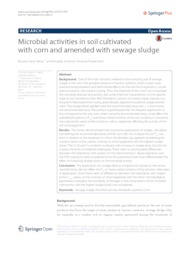Microbial activities in soil cultivated with corn and amended with sewage sludge. Microbial activities in soil cultivated with corn and amended with sewage sludge.
Microbial activities in soil cultivated with corn and amended with sewage sludge. Microbial activities in soil cultivated with corn and amended with sewage sludge.
Author(s): VIEIRA, R. F.; PAZIANOTTO, R. A. A.
Summary: Background: One of the main concerns related to the increasing use of sewage sludge in the soil is the possible presence of excess nutrients, which could cause environmental problems and detrimental e?ects on the soil microorganisms, considered essential to soil nutrient cycling. Thus, the objective of this work was to evaluate the microbial biomass and activity and some chemical characteristics of one speci?c tropical soil, classi?ed as Dark Red Distroferric Latosol, of a loamy/clayey texture, in a long-term ?eld experiment using anaerobically digested household sludge amendment. The sludge doses applied were the recommended dose and 2, 4 and 8 times the recommended dose. The authors hypothesized that the frequent application of this compound to the soil, even when using the recommended dose, could a?ect the available phosphorus (Pav) and heavy metal contents of the soil, resulting in concentrations above the needs of the culture as well as negatively a?ecting the activity of the soil microorganisms. Results: The results demonstrated that successive applications of sludge, calculated considering the recommended dose of N for corn, did not increase the soil Pav contents in relation to the treatment in which the fertilizer was applied considering the nutrient needs of the culture, contrary to what happened with the highest sludge doses. The Cr, Ni and Cu contents increased with increase in sludge dose, but did not surpass the limits considered inadequate. There were no accentuated di?erences between the treatments with respect to microbial biomass C. Basal respiration and the FDA hydrolysis were considered to be the parameters that most di?erentiated the e?ect of increasing sludge doses on the microbial activity. Conclusion: The application of a sludge dose to a tropical soil, based on the recommended dose, did not a?ect the Pav or heavy metal contents of the soil even after years of application. Since there were no di?erences between the treatments with respect to the Cmic values, to the contrary of what happened with the other microbiological parameters evaluated, the possibility of changes in the composition of the microbial community with the higher sludge doses was considered.
Publication year: 2016
Types of publication: Journal article
Unit: Embrapa Environment
Observation
Some of Embrapa's publications are published as ePub files. To read them, use or download one of the following free software options to your computer or mobile device. Android: Google Play Books; IOS: iBooks; Windows and Linux: Calibre.
Access other publications
Access the Agricultural Research Database (BDPA) to consult Embrapa's full library collection and records.
Visit Embrapa Bookstore to purchase books and other publications sold by Embrapa.

